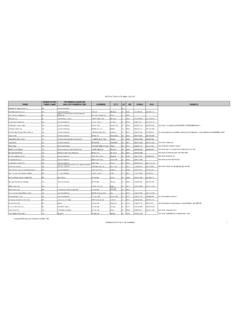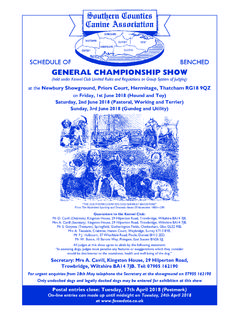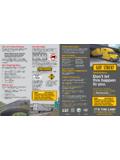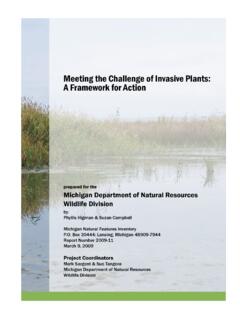Transcription of Conserving Alabama’s Coastal Habitats: Acquisition …
1 Conserving alabama s Coastal Habitats: Acquisition and restoration priorities of Mobile and Baldwin CountiesMarch, 2006 Prepared byThe Mobile Bay National Estuary Program in partnership with The Nature Conservancyunder a contract with the Gulf of Mexico ProgramFor proprietary use by the Coastal Habitats Coordinating Team, The Nature Conservancy, and Mobile Bay National Estuary Program 1 Table of ContentsPreface ..2 Introduction ..3 Conservation and restoration Methods ..4 Guiding Principles for Conservation Activities ..4 Overview of Four Target Areas ..5 Methodology ..6 Priority Acquisition Sites ..8 Overview Map of All Acquisition Sites ..9 Acquisition priorities by Conservation Area ..11 Grand Bay .. : Cat Island ..142a. Map: Coppersmith-Cedar Point ..152b. Map: Dezauch Tract.
2 162c. Map: Tensaw Land and Timber ..172d. Map: Henderson Tract - East Grand Bay ..182e. Map: West Fowl River Tract ..193a. Map: Whitehead Tract ..203b. Map: MC Davis Tract ..214a. Map: Solet Tract ..224b. Map: Henderson Tract ..23 Gulf Islands .. : Dauphin Island Migratory Bird Stopover Tracts .. :Peninsula Tract .. : West End of Dauphin Island .. : Gulf State Park In-Holdings ..32 Mobile Delta .. :Bayou Sara Tracts .. : Coastal Land Trust (ALCO) Tract ..3711. Map: Hells Creek Swamp ..3812. Map: Live Oak Landing ..3913a. Map: Weeks Bay Tract ..4013b. Map: Upper Weeks Bay ..41 Perdido River ..4314. Map: AIG Baker/Reeder Lake Tract ..4715. Map: IP Perdido River Tracts .. :Lillian Swamp ..4917. Map: Perdido River Delta LLP Connector.
3 50 restoration priorities : Detail by Conservation Area ..51 Priority Areas for restoration .. Mississippi Sound restoration Sites .. Bay Upland restoration Sites .. Islands restoration Sites .. Bay/Delta restoration Sites .. Tensaw River Delta restoration Sites .. Perdido Corridor restoration Sites .. River restoration Sites ..64 Conservation Organizations ..66 2 PrefaceThe Mobile Bay National Estuary Program Management Conference, which generally represents all stakeholdersof the estuary, established an objective in its Comprehensive Conservation Management Plan (CCMP) publishedin April 2002 to provide optimum fish and wildlife habitat in the Mobile Bay system by effectively preserving,restoring, and managing resources to maintain adequate extent, diversity, distribution, connectivity and naturalfunctions of all habitat types.
4 The concern was that high quality Coastal habitats within the Mobile Bay NationalEstuary Program target area were not protected from certain habitat threats loss or reduction of species with specific habitat requirements could result. Many of these habitat threats are associated with population growth andinclude: habitat destruction, degradation, fragmentation, water quantity and quality impacts, non-native speciesand the suppression of natural ecological processes such as periodic fire. habitat destruction and change have alsorecently resulted from the impacts of two of the most destructive hurricanes to strike the (Ivan and Katrina.)Direct effects of these storms on sensitive habitat and the secondary impacts resulting from recovery and rebuildefforts must also be considered as we seek to maintain and preserve our sensitive Coastal ecology.
5 In response tothis concern, the CCMP includes this habitat Management Sub-objective:Protect, enhance, restore and manage valuable public landsand work with private property owners to accomplish habitatprotection goals on important, privately held lands, including the Acquisition of 15 additional high priority sites by 2009 through purchase or through other instruments, such as sub-objective constitutes the foundation of the Acquisition and restoration priorities of Mobile and Baldwin 2004 the Mobile Bay National Estuary Program (MBNEP) was awarded a grant by the EPA Gulf of MexicoProgram to conduct a strategic assessment of habitats throughout Mobile and Baldwin counties that would identifypriority sites for Acquisition and restoration . At the same time, The Nature Conservancy of alabama (TNC) wasgoing through an internal process to identify priority habitats through its Conservation by DesignEffromysonConservation Workshop methodology.
6 This is a process that assesses habitats for conservation based on quality ofor contributions to the ecosystem, stresses to those systems, sources of the stresses, strategies to abate those sourcesand success in terms of measuring biodiversity health and threat abatement with the goal of the long-term survivalof all viable native species and communities. Recognizing their common objectives, MBNEP and TNC decided topartner and conduct a one-year conservation planning effort using this ecosystem based process to focus on the following conservation areas: Perdido River Corridor, the Gulf Islands, the Mobile Bay & Delta, and the Grand Bay. This effort resulted in the identification of 17 priority Acquisition sites (or other conservation options) and over30 other sites/ habitat types where restoration and/or enhancement are considered viable and necessary.
7 Thesesites have been put in this Atlas to be used by governments and other community organizations to more effectively guide resource management activities in Coastal alabama . Indeed, some state and local agencies and organizations have already acquired or are already working to acquire certain sites on the list. Similarly, restoration activities are underway or being planned in a number of the identified need for such an assessment arose because of the many organizations, governments and agencies actively pursuing habitat Acquisition , preservation restoration , and management activities in the alabama Coastal their efforts are ineffective in protecting and managing critical habitat because ways to prioritize activitiesand communicate what individual groups are doing to acquire, preserve, and restore habitat are lacking.
8 The problem is exacerbated by individually applying for funding to various agencies and organizations. Through the strategic assessment process the contributions of existing preservation and management programs and thecapabilities of all agencies and organizations involved in these programs are coordinated and partners and participants in this strategic assessment covered a wide spectrum of public and private interests including:the Army Corps of Engineers, Fish and Wildlife Service, Department ofAgriculture s Natural Resources and Conservation Service, Mississippi- alabama Sea Grant, AlabamaDepartment of Conservation and Natural Resources State Lands Division, alabama Forest Resources Council,Weeks Bay National Estuarine Research Reserve, Mobile and Baldwin County governments, Mobile BayAudubon Society,Dauphin Island Bird Sanctuary, alabama Coastal Foundation, alabama Power Company andothers such as local conservationists and realtors.
9 Although long term success will be judged on the degree to which identified sites are protected or restored, shortterm results are promising. For example, sites and areas identified in the habitat strategic assessment have alsobeen included as priorities for Acquisition in recent state planning documents in response to the Coastal andEstuarine Land Protection Program (CELP). Further, efforts to create a data base for Coastal habitat restorationare in progress. The Mississippi- alabama Sea Grant Program initiated this data base and funded its developmentin response to the need to be able to track on-going restoration projects and the Mobile Bay National EstuaryProgram will be responsible for managing and maintaining it as part of its Data and Information ManagementSystem.
10 Finally, a steering committee called the Coastal Habitats Coordinating Team (CHCT) has been createdand left in place to promote a continuing focus on habitat needs in CHCT, the Mobile Bay National EstuaryProgram will work to develop the public-private partnerships necessary to effectively conserve critical habitatsthroughout Coastal conservation, protection and restoration are very much community concerns in Coastal alabama . Thedevelopment of effective partnerships and tools such as these, help us better utilize and target existing capabilities,resources, and funding for achieving habitat goals and assist in preventing and diffusing our individual efforts. 4 Conservation and restoration MethodsThe above properties identified for habitat conservation and restoration will require long-term site protectionmeasures to ensure their conservation into perpetuity.







